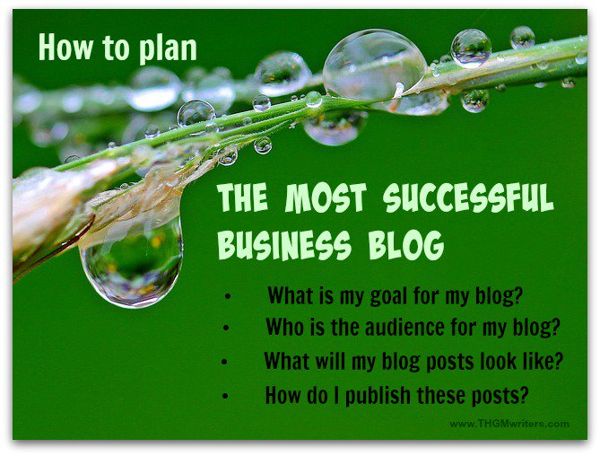It’s finally starting to sink in; if you’re in business on the Internet, you should have a blog. But not every entrepreneur knows how to set up a blog to be successful.
I still recall when every business was just realizing that they should have a website. But just “having” the website wasn’t going to make them money.
Just “having” a blog won’t make a difference, either; it’s what you do with the blog that counts. To have a successful blog, you need to plan a successful blog. Here are four planning questions you need to ask:

What is my goal for my blog?
“I want to make more money” is not a plan. You need to define specific goals, and you need to decide which is the top goal. Here are examples of some blogging goals:
- I want to showcase my knowledge and expertise.
- I want to put detailed answers to prospects’ and customers’ questions online.
- I want to build a solid nucleus of loyal, engaged fans.
- I want higher search engine rankings.
- I want to showcase our success stories.
- I want to sell on my blog.
- I want my blog to be a destination for potential customers.
The nature of your business might suggest what your goals should be. For instance, if you have a very defined target market, such as dentists or residents of Akron, being a destination might be a good business decision. If your market is less well-defined, that might not be a reasonable goal.
Who is the audience for my blog?
Once you know your goals, you can define your audience. Your audience is not necessarily your target market.
For instance, if your top goal is SEO-related, you’ll want as wide an audience as possible, without wandering off-topic. The more eyeballs you get, the more social shares and inbound links will follow.
If you want to showcase your expertise, you might want to attract not only prospects and customers, but also niche leaders and influencers who might quote you, seek out your opinions or open up other doors for you.
If you want to build a solid nucleus of loyal, engaged fans, your audience might be just a subsection of prospects and customers, and maybe not just them; you might want to attract any fans you can get, because they will spread the word to prospects and customers.
In his guide to starting a blog, Neil Patel suggests creating a persona (right after suggesting that you “figure out the whole point of your blog” – sound familiar?). Here is his example of a persona:
“She’s 28, single, an account executive at Trade Marketing Organization. She lives in a north Philly suburb. She makes $62k a year. She drives a Toyota Prius. She lives in a single level Craftsman home.”
Now you have someone to write to. That doesn’t mean that men, Texans and Honda drivers won’t be interested in what you write. But it does mean that you know where to aim, where your target reader’s bull’s eye is.
What will my blog posts look like?
Once you know your goals and your audience, you can define what you want to write about, what style you’ll use, and how long your posts should be. These can vary quite a bit.
If your goal is to showcase your expertise, and your audience includes prospects, customers and influencers, you will want to write a substantial amount in at least a semi-formal manner. You might want to use some big words (but not too many) and you’ll most likely follow a format of identifying a challenge and explaining how you solved it. The topics will be serious and professional-related. You’ll want to post things that tell people you are the go-to person in your niche.
If, on the other hand, your goal is to be a destination and your audience is anyone within a specific community (Akron, for example), then you’ll want to write somewhat shorter, chatty posts about events and news and people in the community. You’ll want to post things that keep people in your larger market coming back.
There are three ways to write for the web:
- Sales copy
- Task-oriented content
- Storytelling
Your goals and your audience will determine which one to use.
How do I publish these posts?
WordPress. Create a folder on your website called “blog” (or some other name, if you wish), and upload the free WordPress CMS. Customize as you wish, or save that for later. Ideally, the blog will have a common look and feel with the rest of your website.
There are other content management systems for blogging, but none are as ubiquitous, as well-updated and as easy to find coders for in a pinch as WordPress is.
Once WordPress is set up, with whatever plugins and extras you wish, you can publish your first post. You do not have to get everything perfect in the set-up before you start. There will be plenty of time later to tweak the design and play with plugins.
Remember that the blog posts are just content around which you build your goals. Your goals always involve people; you still have to get those people to engage with your content. So there is a lot of promotion involved, too. Keep feeding it content and keep feeding it people.
Just having a blog or a website isn’t enough. You have to draw in the people and interact with them. But before you do that, you have to plan. Without a plan, your business blog won’t be successful.
By: David Leonhardt is a freelance writer with eclectic taste. He writes books, speeches and articles, and he has a team that helps with screenplays, fiction and other specialty projects.

